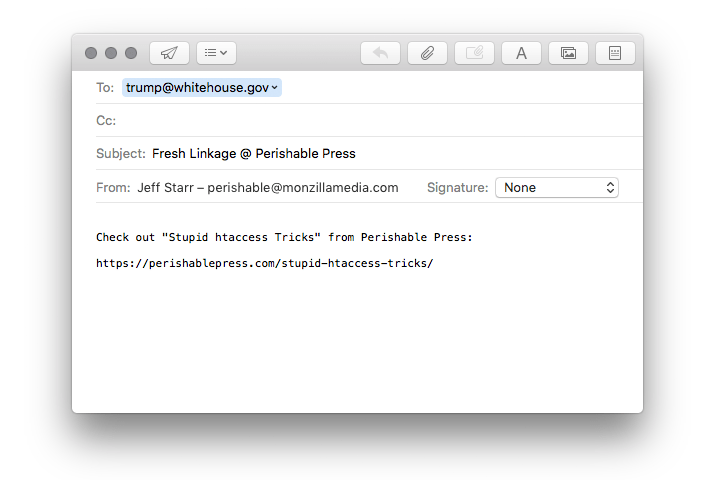Here is my custom list of abbreviations for commonly used terms, as written via HTML’s <abbr></abbr> tag. I’m posting this to make it available to anyone who finds it useful. Very handy when writing tutorials related to WordPress, web design and development. A quick copy/paste is much quicker than typing it all out. Without further ado, here is my “cheat sheet” of HTML abbreviations. Continue reading »

Typography is inspiring :) I recently posted about all the different HTML “X” characters. Then a tweet from Helge Klein inspired me to write a follow-up post showing all the different ways to write a dash or hyphen – character in HTML. Like most online content creators, I knew about – and —. But I didn’t realize there were so many other hyphen and dash characters. Continue reading »

This post explains all the different “x” characters currently available in HTML. It covers the various HTML entities and provides some examples and tips. Also explains the difference between the often confused “Multiplication X” and “Multiplication Sign”, and which is better for symmetrical buttons and links. Continue reading »

By now most have heard about the WP Sitemaps feature introduced in WordPress version 5.5. From what I’ve read most existing sites that needed a sitemap already had one via one of the many free sitemap plugins. But for new WordPress sites going forward, having all the sitemap code in the WordPress core now means that new sites have the option of rolling with the default WordPress sitemaps, or use a dedicated plugin to do the job. This post is […] Continue reading »
While working on the site’s 24th redesign, I ended up with about 10 code snippets that were awesome but ultimately not needed. So rather than just delete these tasty functions, I am posting them here for future reference. Who knows, during the next site update I may decide to implement or repurpose some of these techniques. And of course sharing is caring, so feel free to use any of these code snippets in your own projects. Check out the Table […] Continue reading »
![[ WP Visual/RTE Insert Link Dialog ]](https://perishablepress.com/wp/wp-content/images/2018/wp-rte-insert-link.png)
For those who haven’t yet noticed, WordPress now adds rel="noopener" attributes for any external links added via the link Quicktag in the Visual/RTE. So if you enable the option, “Open link in a new tab”, WordPress automatically will add the rel noopener attribute to the link. This is to protect against CORS and other exploits that take advantage of blank-target links. It’s a smart move that may escape many in the WordPress community. So in an effort to help foster […] Continue reading »
![[ WordPress: Developing Secure WordPress Sites ]](https://perishablepress.com/wp/wp-content/images/2016/secure-wordpress-sites.png)
After months of preparation and production, my new video course on developing secure WordPress sites is now available at Lynda.com. This is my second video course on securing WordPress; the first one was originally launched in 2011 and remained in Lynda’s library for over five years. I received a lot of great feedback on the course, and so I jumped on the opportunity to do another one. If there is one thing that I enjoy doing, it’s helping people with […] Continue reading »
![[ Decoding PHP ]](https://perishablepress.com/wp/wp-content/images/2012/decoding-php-code.jpg)
There are many ways to encode and decode PHP code. From the perspective of site security, there are three PHP functions — str_rot13(), base64_encode(), and gzinflate — that are frequently used to obfuscate malicious strings of PHP code. For those involved in the securing of websites, understanding how these functions are used to encode and decode encrypted chunks of PHP data is critical to accurate monitoring and expedient attack recovery. Continue reading »
![[ RSS Feed Icon ]](https://perishablepress.com/wp/wp-content/images/2011/rss-feed-icon-128.png)
Converting small images to data-URLs is a great way to eliminate HTTP requests and decrease loading time for your pages. Using PHP‘s base64_encode() and base64_decode() functions, we have the power to convert images to data-URLs and vice-versa. This article explains how it all works, and shows some different ways of converting back and forth between original and encoded images. Continue reading »
![[ HTML5 Table Template ]](https://perishablepress.com/wp/wp-content/images/2010/misc-chunks/table-template.png)
A good designer knows that tables should not be used for layout, but rather for displaying columns and rows of data. HTML enables the creation of well-structured, well-formatted tables, but they’re used infrequently enough to make remembering all of the different elements and attributes rather time-consuming and tedious. So to make things easier, here is a clean HTML5 template to speed-up development for your next project.. Continue reading »
If you operate a website that features lots of code examples, you know how important it is to spend some quality time styling the <pre></pre> element. When left unstyled, wild <pre></pre> tags will mangle your preformatted content and destroy your site’s layout. Different browsers treat the <pre></pre> tag quite differently, varying greatly in their default handling of font-sizing, scrollbar-rendering, and word-wrapping. Indeed, getting your preformatted code to look consistent, usable, and stylish across browsers is no easy task, but it […] Continue reading »
While browsing the internet these days, I see a lot of this: <body> … <a name="top"></a> … <a href="#top">- Back to Top -</a> … </body> There’s an easier, better and prettier way. CSS Signatures are all the rage these days. If you’re not familiar with a CSS Signature, it’s basically nothing more than an ID on your body tag, like this: <body id="www-domain-tld"></body> The fundamental purpose of the CSS Signature is to allow a user to specify style adjustments to […] Continue reading »
Behold the ubiquitous list elements, <ul></ul> and <ol></ol>! These two sexy elements help millions of websites display lists of information in clean, semantic fashion. Without them, we’d be crawling around like filthy cavemen, eating dirt and howling at the moon. But these list elements aren’t just sexy, they are also extremely flexible, enabling us humble designers to create robust list configurations that are semantically versatile and highly customizable. We all know how to throw down a basic list: Continue reading »
![[ Electrical Surge ]](https://perishablepress.com/wp/wp-content/images/2009/misc-chunks/html-css-power.jpg)
Web designers can do some pretty cool stuff with HTML 4 and CSS 2.1. We can structure our documents logically and create information-rich sites without relying on archaic, table-based layouts. We can style our web pages with beauty and detail without resorting to inline <font></font> and <br /> tags. Indeed, our current design methods have taken us far beyond the hellish era of browser wars, proprietary protocols, and those hideous flashing, scrolling, and blinking web pages. Thankfully, those days are over. As […] Continue reading »

In addition to your choice collection of “Share This” links, you may also want to provide visitors with a link that enables them to quickly and easily send the URL permalink of any post to their friends via email. This is a great way to increase your readership and further your influence. Just copy & paste the following code into the desired location in your page template: <a href="mailto:?subject=Fresh%20Linkage%20@%20Perishable%20Press&body=Check%20out%20<?php the_permalink(); ?>%20from%20Perishable%20Press" title="Send a link to this post via email" rel="nofollow">Share […] Continue reading »
![[ #1 ]](https://perishablepress.com/wp/wp-content/images/2009/eight-blacklist/01.gif)
With the imminent release of the next series of (4G) blacklist articles here at Perishable Press, now is the perfect time to examine eight of the most commonly employed blacklisting methods achieved with Apache’s incredible rewrite module, mod_rewrite. In addition to facilitating site security, the techniques presented in this article will improve your understanding of the different rewrite methods available with Apache mod_rewrite. Note: I changed the title of this post from “Eight Ways to Blacklist..” to “Eight Ways to […] Continue reading »



![[ WP Visual/RTE Insert Link Dialog ]](https://perishablepress.com/wp/wp-content/images/2018/wp-rte-insert-link.png)
![[ WordPress: Developing Secure WordPress Sites ]](https://perishablepress.com/wp/wp-content/images/2016/secure-wordpress-sites.png)
![[ Decoding PHP ]](https://perishablepress.com/wp/wp-content/images/2012/decoding-php-code.jpg)
![[ HTML5 Table Template ]](https://perishablepress.com/wp/wp-content/images/2010/misc-chunks/table-template.png)
![[ Electrical Surge ]](https://perishablepress.com/wp/wp-content/images/2009/misc-chunks/html-css-power.jpg)

![[ #1 ]](https://perishablepress.com/wp/wp-content/images/2009/eight-blacklist/01.gif)
